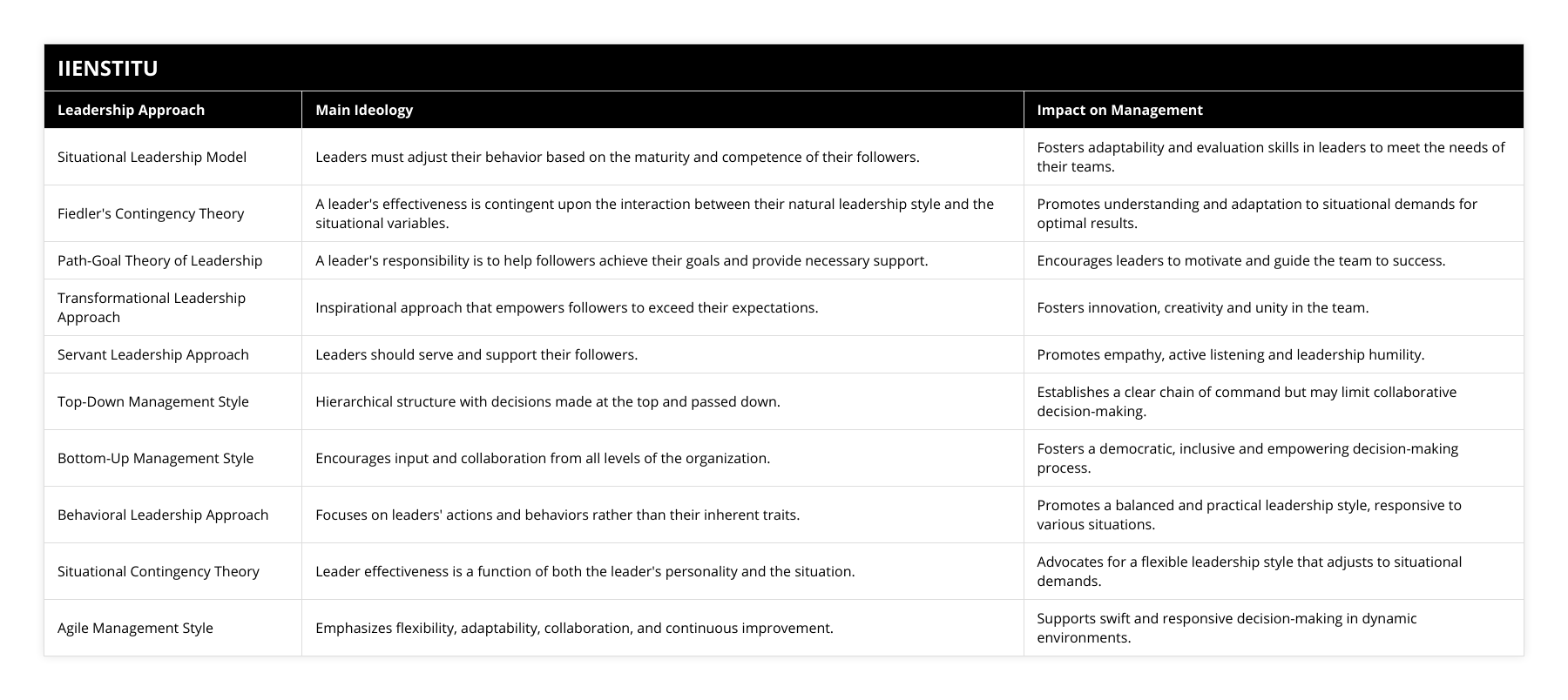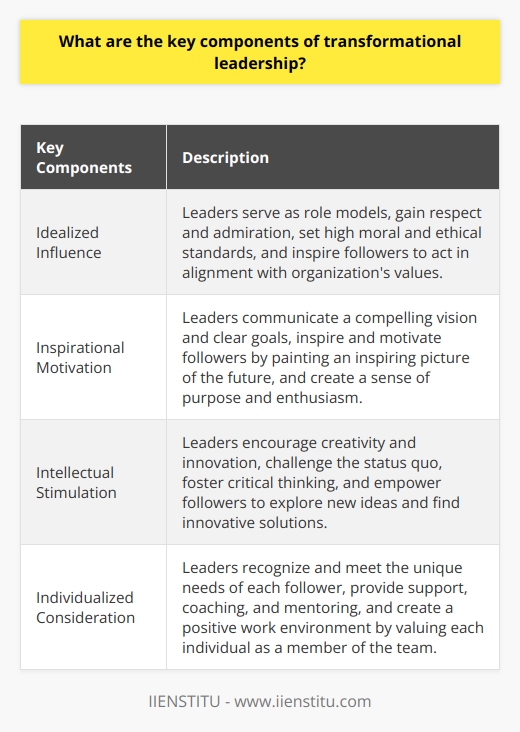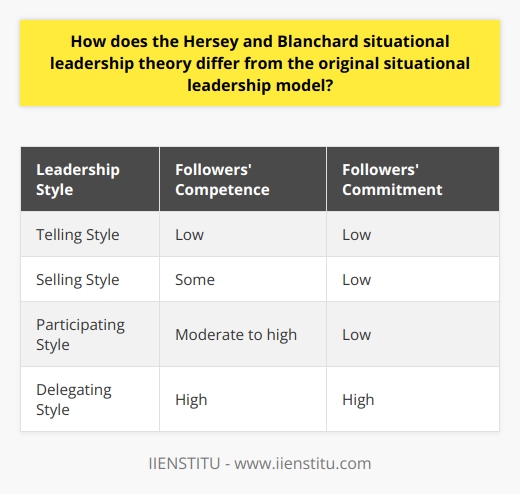
Leadership is a multifaceted concept that has evolved significantly over time. As a result, studying leadership styles and approaches has generated various theories, models, and strategies to help us understand and practice effective leadership. In this blog post, we will delve into some of the most influential and contemporary leadership theories and models, including the situational leadership model, Fiedler's contingency theory, the path-goal theory, and the transformational and servant leadership approach.
Related Course: Leadership Training Course
Understanding the Situational Leadership Model
The situational leadership model, developed by Paul Hersey and Ken Blanchard, posits that the context and adaptability of the leader determine effective leadership. According to the Hersey-Blanchard situational leadership model, leaders must adjust their behavior and leadership style based on the maturity and competence of their followers. In addition, this approach emphasizes the importance of the leader's ability to evaluate the needs of their team and adjust their leadership style accordingly.
Exploring Fiedler's Contingency Theory
Fiedler's contingency theory, developed by Fred Fiedler, is another influential leadership approach focusing on the situational factors influencing leadership effectiveness. The central premise of this theory is that a leader's effectiveness is contingent upon the interaction between their natural leadership style and the situational variables. Fiedler's contingency theory posits that leaders can be classified into task-oriented and relationship-oriented categories. Leaders must understand their natural tendencies and adapt to the demands of the specific situation to achieve the best results.
Examining the Path-Goal Theory of Leadership
The path-goal theory, proposed by Robert House, suggests that a leader's primary responsibility is to help their followers achieve their goals and provide the necessary support, guidance, and resources. This theory highlights four leadership styles: directive, supportive, participative, and achievement-oriented. By understanding their followers' needs, leaders can apply the most suitable leadership style to motivate and guide their team toward success.
Embracing the Transformational Leadership Approach
Transformational leadership, a famous contemporary approach, inspires and empowers followers to achieve their full potential and exceed their expectations. This approach is characterized by four key components: idealized influence, inspirational motivation, intellectual stimulation, and individualized consideration. By adopting a transformational leadership style, leaders can foster innovation, creativity, and a strong sense of purpose within their teams.
Adopting the Servant Leadership Approach
The servant leadership approach, championed by Robert Greenleaf, emphasizes the leader's role in serving and supporting their followers. This approach prioritizes the team's needs and encourages leaders to develop deep empathy and understanding toward their followers. Servant leaders demonstrate humility, active listening, and a genuine desire to help their followers grow and develop.
Comparing Top-Down and Bottom-Up Management Styles
Top-down and bottom-up management styles represent two contrasting approaches to leadership and decision-making. A top-down management style is characterized by a hierarchical structure where decisions are made at the top and passed down through the organization. In contrast, a bottom-up management style encourages input and collaboration from all levels of the organization, fostering a more democratic and inclusive decision-making process.
The Behavioral Leadership Approach
The behavioral leadership approach focuses on leaders' specific actions and behaviors rather than their inherent traits or characteristics. This approach classifies leadership behaviors into two main categories: task-oriented and relationship-oriented. As a result, leaders can adopt a more holistic and practical leadership style by balancing these two aspects.
Navigating Different Leadership Approaches
With numerous leadership theories and models available, it can be challenging to determine the most suitable approach for a given situation. Leaders need to recognize that every leadership style or approach is universally effective. Instead, they must develop the ability to adapt and respond to the unique demands of their context and the needs of their followers.
The Role of Agile Management Style in Leadership
The agile management style has gained prominence recently, particularly in fast-paced, dynamic industries such as technology and software development. Agile leadership emphasizes flexibility, adaptability, and responsiveness to change. Leaders employing this style prioritize collaboration, continuous improvement, and iterative decision-making, allowing organizations to pivot quickly and effectively in response to shifting circumstances.
Analyzing the Situational Contingency Theory
The situational contingency theory, a broader extension of Fiedler's contingency theory, explores the interplay between various situational factors and leadership effectiveness. This theory posits that the most effective leadership style depends on follower competence, leader-member relations, and task structure. By considering these factors, leaders can tailor their approach to maximize effectiveness in diverse situations.
Delving into the Style Approach to Leadership
The style approach to leadership emphasizes the importance of understanding and utilizing different leadership styles to achieve the best outcomes. This approach encourages leaders to develop a repertoire of leadership styles and adapt their approach based on the context, follower needs, and organizational goals. A comprehensive understanding of various leadership styles can empower leaders to navigate complex situations confidently and skillfully.
Investigating the Hersey and Blanchard Situational Leadership Theory
The Hersey and Blanchard situational leadership theory is a refined version of the situational leadership model, which further emphasizes the importance of adapting leadership styles based on the maturity and competence of followers. The theory identifies four main leadership styles: telling, selling, participating, and delegating. By effectively understanding and applying these styles, leaders can maximize their impact and better support their followers' development.
Types of Leadership Approaches
In addition to the theories and models discussed thus far, several other types of leadership approach warrant exploration. Some of these approaches include:
Transactional leadership focuses on the exchange between leaders and followers, emphasizing rewards and consequences for performance.
Charismatic leadership is characterized by a leader's ability to inspire and motivate followers through charisma and personal appeal.
Authentic leadership emphasizes self-awareness, transparency, and ethical behavior as the foundation for effective leadership.
Situational Leadership Theory Definition
The situational leadership theory is defined as an adaptive leadership approach that emphasizes the importance of adjusting one's leadership style based on the situation's specific demands and followers' needs. This theory underscores the idea that effective leadership is not a one-size-fits-all proposition but requires flexibility, adaptability, and a keen understanding of contextual factors.
Enhancing Readability with Subheadings and Concise Language
In writing about leadership styles and approaches, it is essential to prioritize readability and accessibility for a diverse audience. By incorporating subheadings, utilizing concise language, and adhering to sentence and paragraph length guidelines, writers can ensure that their content is engaging, informative, and easy to digest.
Conclusion
In summary, effective leadership is a complex and dynamic process that requires a deep understanding of various styles, approaches, and theories. By developing a comprehensive understanding of these concepts, leaders can equip themselves with the tools necessary to adapt their leadership style based on the unique demands of their context and the needs of their followers. Furthermore, by adopting an adaptive and flexible leadership approach, leaders can empower their teams, foster innovation, and drive organizational success.
Effective leadership requires flexibility, adaptability, and a keen understanding of contextual factors.

Frequently Asked Questions
What are the key components of transformational leadership?
The key components of transformational leadership are idealized influence, inspirational motivation, intellectual stimulation, and individualized consideration.

How does the Hersey and Blanchard situational leadership theory differ from the original situational leadership model?
The Hersey and Blanchard situational leadership theory refines the original model by emphasizing the importance of adapting leadership styles based on the maturity and competence of followers and introducing four main leadership styles: telling, selling, participating and delegating.

What are the primary differences between top-down and bottom-up management styles?
Top-down management relied on a hierarchical decision-making process, with decisions made at the top and passed down through the organization. In contrast, bottom-up control encourages input and collaboration from all levels of the organization, fostering a more democratic and inclusive decision-making process.
What are the five distinct leadership styles for effective management, and how do they differ in terms of decision-making and team dynamics?
Autocratic Leadership
First, autocratic leadership operates on the principle of centralizing power and decision-making in one person. Here, the leader controls all decisions and exercises authority without involving team members.
Democratic Leadership
Contrarily, democratic leadership involves team members in decision making. This inclusive approach fosters creativity and participation, enhancing ownership and productivity among team members.
Transformational Leadership
Transformational leadership, as the name suggests, emphasizes transforming an organization through its people. Such leaders inspire and motivate their team members. They prioritize intellectual stimulation and encourage employees to bring forward new ideas and challenge existing norms.
Laissez-Faire Leadership
The laissez-faire leadership style involves minimal managerial oversight, with leaders giving team members the autonomy to make their own decisions. This style can work well with highly skilled and self-motivated employees but can lead to chaos if not monitored.
Servant Leadership
Lastly, the servant leadership style rotates around the leader acting as a 'servant' to the team. These leaders prioritize the needs of the team over their own, promoting collaboration, trust, and harmony.
In sum, each leadership style carries a unique approach and impact on decision-making and team dynamics. Autocratic leaders make decisions autonomously, which might limit creativity, whereas democratic and servant leaders focus highly on collaborative decision-making, fostering greater innovation and commitment. The hands-off approach of laissez-faire leaders can catalyze independence among skilled staff but might risk a lack of direction. Finally, transformational leaders constantly drive change and innovation through their inspiring approach, garnering high levels of engagement and initiative within the team.

Can you explain the various approaches to leadership and management, and how they may be applied in varying organizational contexts?
Transactional Leadership Approach
Transactional leadership means setting clear objectives and rewards for meeting those objectives. This motivates employees to improve their performance. Businesses frequently use it in sales environments.
Transformational Leadership Approach
Transformational leadership involves inspiring and motivating staff to surpass their own personal goals. The leader acts as a role model, creating a supportive environment. Education, healthcare and nonprofits often prefer this style.
Participative Leadership Approach
Participative leadership encourages participation from all members in decision making. This type of leadership harnesses the unique skills and abilities of every group member, thus enhancing employee satisfaction and team performance. Smaller organizations typically use this approach.
Autocratic Leadership Approach
Autocratic leaders make all the decisions without input from team members. Such leadership allows for quick decision-making but can be limiting. This approach is common in military or situations requiring strict adherence to rules.
Laissez-faire Leadership Approach
In laissez-faire leadership, leaders offer little to no guidance to group members and give subordinates the freedom to make decisions. Creative industries like advertising or tech startups may benefit from this style.
Situational Leadership Approach
Situational leadership adapts to the most advantageous style depending on the situation. It factors in on the abilities and skills of team members and the intensity of the situation. This leadership works best for organizations with rapidly changing environments.
In conclusion, different leadership and management approaches would be effective based on the team's size, nature of work, and the organization's goals and dynamics. Applying the right leadership style can significantly increase an organization's efficiency and productivity.

How do the four primary leadership styles impact organizational culture and employee engagement?
Autocratic Leadership Impact
Autocratic leadership style is most commanding. Leaders make decisions independently with scant consideration for employee input, which can lead to low staff morale and greater turnover.
Transformational Leadership Impact
In contrast, transformational leaders inspire and motivate employees, fostering creativity and initiative. Consequently, this leadership style can lead to high levels of engagement, diminished turnover, and a thriving organizational culture emphasizing innovation and growth.
Democratic Leadership Impact
Democratic leadership promotes employee participation in decision-making processes. By encouraging discussion and incorporating employee suggestions, democratic leaders foster an inclusive culture, fostering high levels of staff satisfaction and engagement, thereby enhancing productivity.
Laissez-Faire Leadership Impact
Laissez-faire leaders take a hands-off approach, entrusting responsibilities to team members with little oversight. This leadership style can foster an independent culture, yet without clear guidance and support, it may lead to poor engagement, negatively impacting productivity overall.
In summary, the leadership style significantly influences organizational culture and employee engagement. Consequently, leaders should adopt an appropriate style that not only aligns with the organizational culture but also promotes high levels of employee engagement.



